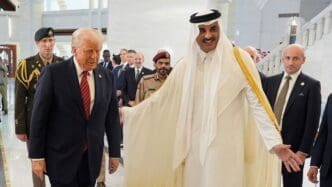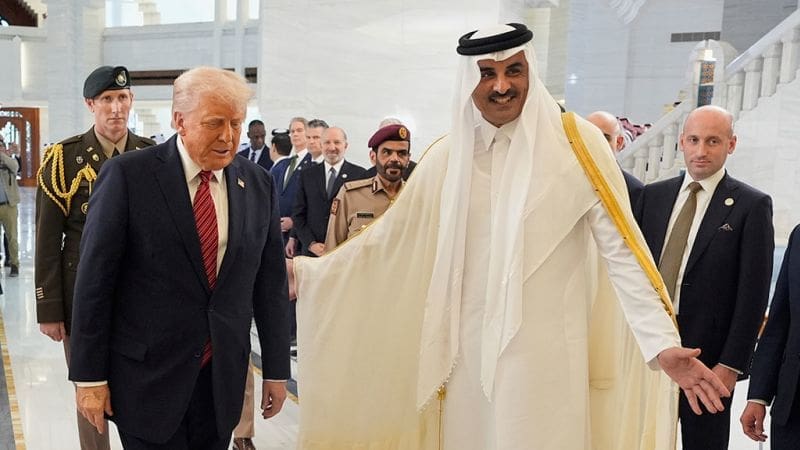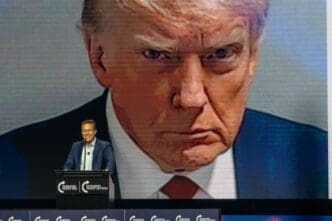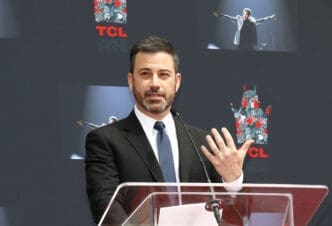President Donald Trump’s recent tour of the Middle East, initially perceived as a mere opportunity to showcase his prowess as a dealmaker, has unfolded into a complex geopolitical maneuver impacting the region significantly. While the White House had aligned the trip with economic agreements and ceremonial displays, such as contracts worth billions and pageants featuring camels, the president’s actions have exceeded these expectations, introducing substantial diplomatic shifts.
A pivotal decision during this tour was the lifting of U.S. sanctions on Syria, a move designed to offer the war-torn nation a fresh chance at stabilization. This bold step has reignited discussions about Trump’s broader foreign and trade policy strategies, questioning whether his initiatives can yield sustainable solutions.
Despite the White House’s tendency to amplify Trump’s achievements, a significant transaction involving Qatar’s purchase of Boeing aircraft gained more media traction than a potentially historic meeting with Syrian leader Ahmed al-Sharaa in Riyadh. This encounter marked the first dialogue between U.S. and Syrian leaders in over two decades, potentially becoming a hallmark of Trump’s Middle East engagement.
Al-Sharaa, formerly a rebel leader with ties to al-Qaeda and a former target of U.S. bounties, has taken over after deposing Bashar al-Assad. Trump’s engagement with him, including lifting sanctions, aims to unify Syria and alleviate the severe humanitarian crisis plaguing its population.
The president’s Middle East strategy extends beyond Syria. Trump has intensified pressure on Iran to restrict its nuclear ambitions, hinting at military repercussions but primarily aiming to avert another regional conflict. Furthermore, Trump’s relationship with Israeli Prime Minister Benjamin Netanyahu is under strain, highlighted by divergent views on issues like the U.S. pact to halt rocket fire in Yemen and the handling of the Gaza crisis, where Trump bypassed Israeli input.
Trump’s itinerary also included plans to mediate the ongoing conflict between Russia and Ukraine through a potential meeting in Turkey with Presidents Vladimir Putin and Volodymyr Zelensky. However, the absence of these leaders from the planned talks led to a reassessment of this peace initiative.
The Syrian sanctions relief, one of Trump’s boldest foreign policy moves in his second term, underscores the critical juncture Syria faces. With potential for further chaos if not addressed, Trump’s decision reflects a strategic gamble to stabilize the region. Al-Sharaa’s potential recognition of Israel could signify a monumental regional shift.
The decision has garnered support, even from critics, reflecting a broader willingness to prioritize stability over past grievances. However, concerns linger about the protection of minorities within Syria and the need for assurances against ISIS resurgence before congressional approval of sanction waivers.
While Trump’s move is supported by Saudi Arabia and Qatar, aiming to prevent unrest from spreading, it represents a calculated risk. The effectiveness of this decision hinges on swift implementation and addressing U.S. national security priorities.
Senators Jim Risch and Jeanne Shaheen emphasize the importance of coordinated efforts with allies to sustain Syria’s path towards stability and freedom from malign influences. However, South Carolina Senator Lindsey Graham warns of the complex dynamics within Syria, urging caution and collaboration with allied nations.
For Trump to guide Syria’s trajectory effectively, he will need to leverage U.S. influence to rally international support, a challenge compounded by his administration’s staffing complexities. Moreover, Trump’s reliance on Saudi advocacy raises questions about future accountability should the strategy falter.
Ultimately, Trump’s recent diplomatic endeavors, characterized by ambitious trade claims and strategic partnerships, indicate a readiness for bold initiatives, albeit with inherent risks. The president’s affinity for decisive leaders like al-Sharaa, despite their controversial pasts, mirrors historical U.S. policies in the region, underscoring the delicate balance between optimism and caution in Middle East diplomacy. As Trump navigates these intricate geopolitical landscapes, the outcomes of his Middle Eastern tour may well define his foreign policy legacy.








